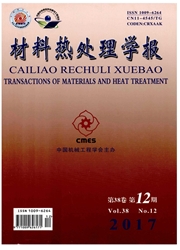

 中文摘要:
中文摘要:
根据传热学理论和数值模拟方法研究温度场的分布规律,在考虑了热物性参数、换热系数、相变潜热随温度变化的因素,应用ANSYS有限元软件的参数化设计语言建立了45钢表面激光重熔连续移动三维瞬态温度场有限元模型。结果表明:提高激光功率对增大相变硬化区效果不大,反而形成较大的熔池而使重熔表面粗糙。与激光功率相比,激光扫描速度对试样温度场的影响较小。经过激光重熔后,形成重熔区、相变硬化区和基体三个区域。实验结果较好地验证了模拟结果,表明所建立的温度场计算模型是正确和可靠的。通过该计算模型,可以掌握金属表面激光重熔过程加热和冷却规律,为制备高性能表面改性层选择合适的工艺参数提供依据。
 英文摘要:
英文摘要:
In order to fully understand the mechanism of laser remehing process on metal surface, distribution of temperature field was studied by numerical simulation method based on heat transfer theory. In view of the characteristics of laser remelting, a travel heat source combined with the surface loads was designed by analyzing both the temperature relativity of the thermal physical parameters of material and the latent heat and the effect of convection radiation on temperature field. A computing model of transient temperature field of three-dimension moving laser remelting on 0.45% carbon steel was built up by using ANSYS parametric design language. The results show that increasing laser power has little influence on the thickness of the hardened zone, however, the surface morphology of the remehed track is coarse due to the great increase of the molten pool. Compared with laser power, scanning rate has less influence on the temperature field distribution of the workpiece. Three different zones form after laser remelting, i.e. remehed zone, hardened zone and substrate. The obtained experimental results show a good agreement with the simulation results, which indicates that the established numerical model is correct and reliable. The model provides a guide for study on the formation and solidification mechanism of laser remelting and the results can be used to optimize the processing parameters.
 同期刊论文项目
同期刊论文项目
 同项目期刊论文
同项目期刊论文
 期刊信息
期刊信息
